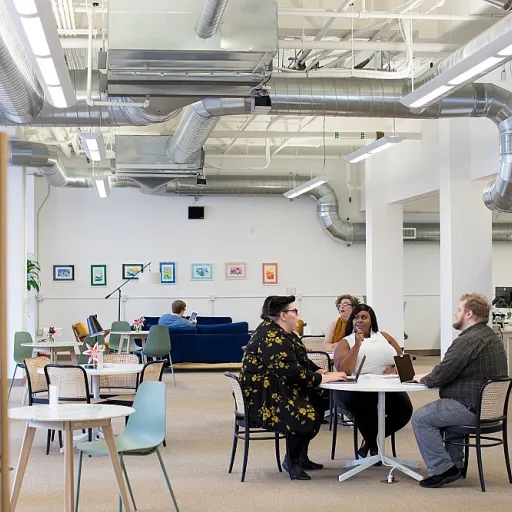
Understanding the Importance of Proper Lighting
When it comes to creating an ideal work environment, enhancing productivity with the right tools is paramount. For those with visual impairments, the importance of proper lighting cannot be overstated. It goes beyond just illuminating a desk; it’s about ensuring that every task - whether sewing, reading, or crafting - is done with ease and comfort.
Why the Right Lighting Matters
Good lighting is more than just a necessity; it's an enabler of independence and efficiency. For the visually impaired, proper lighting means improved vision and easier navigation in both personal and professional spaces. A lamp with a flexible gooseneck, for example, offers adjustable angles, ensuring light can be directed precisely where it’s needed, whether it be over a book, sewing materials, or crafts.
The market hosts a variety of products talking to the needs of the visually impaired. From LED desk lamps and floor lamps equipped with magnifiers to assistive technology like magnifying mirrors and reading lamps, there are numerous options available. These specialized products offer a spectrum of light intensities and features, helping to reduce strain and make daily tasks more manageable.
Considerations for Low Vision Solutions
Selecting the right lamp involves weighing several factors, such as brightness levels, price product, and the specific tasks it will help accomplish. Gooseneck lamps, for instance, provide flexibility, allowing users to adjust their positions easily. Similarly, LED desk lamps often offer adjustable brightness levels, which can be a critical requirement when considering low vision.
Products talking to the need for alerting mechanisms, like sonic alerts, also offer added functionality by signaling the end of a timer or an appointment, using sound rather than sight. These can be integrated into lighting solutions for a comprehensive support system.
Ultimately, the right lighting can significantly enhance both productivity and well-being by improving mobility and accessibility. When searching for a desk lamp locally, it’s crucial to consider not only price but also functionality and suitability to personal needs. This consideration is essential in balancing work and life with tools designed to support every aspect of daily living.
Key Features to Look for in a Desk Lamp
Essential Features for Optimal Lighting
When selecting a desk lamp for the visually impaired, it's crucial to focus on features that enhance visibility and comfort. Proper lighting can significantly impact productivity and well-being, making it essential to choose the right product. Here are some key features to consider:
- Adjustable Brightness: Look for lamps with adjustable brightness settings. This allows users to customize the light intensity according to their needs, whether for reading, sewing crafts, or other tasks.
- LED Technology: LED desk lamps are energy-efficient and provide consistent, flicker-free lighting. They are ideal for reducing eye strain, especially for those with low vision.
- Flexible Gooseneck: A lamp with a flexible gooseneck offers versatility in directing light exactly where it's needed, enhancing the user's ability to focus on specific tasks.
- Magnifying Features: Some lamps come with built-in magnifiers, which are beneficial for reading books or working on detailed projects. Magnifying mirrors can also be a helpful addition.
- Price Considerations: While it's important to find a lamp that meets your needs, consider the price product balance. Investing in a quality lamp can be more cost-effective in the long run.
For more insights on making informed purchasing decisions, you might find this guide on crafting the perfect salary negotiation email helpful, as it offers strategies for evaluating value and cost.
By focusing on these features, you can ensure that your desk lamp not only meets your lighting needs but also contributes positively to your work-life balance.
How Lighting Affects Productivity and Well-being
The Impact of Illumination on Productivity and Well-being
Understanding how light affects productivity and well-being is crucial when selecting a desk lamp. First, consider the type of lighting that a desk lamp provides. LED desk lamps, for example, are popular due to their energy efficiency and long lifespan. These lamps also typically offer a range of brightness levels, allowing you to customize the light to suit your needs. Improper lighting can lead to eye strain and fatigue, especially for those with low vision. Products that include magnifiers or talking products can be particularly beneficial, allowing for enhanced reading and focus, whether you’re diving into books or engaged in sewing crafts. Some even come with magnifying mirrors or flexible goosenecks, providing additional mobility and adaptability. The right choice of desk lamp can positively influence your mood and alerting systems. Viral studies have shown that exposure to natural or proper artificial light can increase serotonin levels, subsequently improving mood and reducing stress—key factors in maintaining a healthy work-life balance. Additionally, for the visually impaired, lamps equipped with sonic alert systems or mobility canes can significantly boost confidence and independence. Products advertised as "floor lamps" or "desk lamp" might offer specific designs catering to the specific needs of low-vision individuals, including features like talking watches or clocks. When evaluating a product, price should not solely determine your decision. Consider how the lamp integrates with assistive technology in your workspace. From talking products to versatile floor lamps, there's an extensive list of solutions that can illuminate your productivity journey effectively.Finding the Right Desk Lamp Nearby
Locating the Ideal Desk Lamp in Your Vicinity
When searching for the perfect desk lamp for those with visual impairments, accessibility and proximity are key factors. Whether you are looking for a lamp to aid in reading, sewing crafts, or other tasks, finding the right product nearby can save you both time and effort. Here are a few tips to help guide your search:
- Visit Local Specialty Stores: Shops that focus on assistive technology often carry a variety of products tailored for low vision needs. These can include LED desk lamps, magnifiers, and talking products.
- Explore Lighting Showrooms: These venues typically offer a vast range of lamps and can provide expertise on the best lighting solutions. They might also have options with flexible goosenecks, which are ideal for mobility and adjustability.
- Check Online Retailers: Many platforms list products that come with detailed descriptions, customer reviews, and competitive pricing. This can include everything from LED lamps on the lower end of the price spectrum to high-end magnifying mirrors and floor lamps.
- Connect with Local Support Groups: Organizations for the visually impaired often have resources or can recommend reputable locations to purchase affordable and effective lighting solutions, such as talking watches and sonic alert systems.
By focusing on local options and reliable sources, you'll ensure not only a satisfying purchase experience but also that the product meets your specific needs and enhances your workspace comfort. Remember, the right desk lamp tailored to your vision requirements is essential for balancing work and life efficiently.
Balancing Work and Life with the Right Tools
Enhancing Your Work Environment
Balancing work and life is a challenge many face, especially when dealing with visual impairments. The right tools can make a significant difference in creating a productive and comfortable workspace. A well-chosen desk lamp, for instance, can transform your work environment, making it easier to focus and reducing eye strain.
Choosing the Right Lighting Tools
When selecting a lamp, consider features that cater to low vision needs. LED desk lamps with adjustable brightness and flexible goosenecks allow you to direct light precisely where needed. This flexibility is crucial for tasks like reading or sewing crafts, where focused light can enhance visibility.
Integrating Assistive Technology
Incorporating assistive technology such as magnifying mirrors or talking products can further aid in maintaining a balanced work-life routine. These tools not only support daily tasks but also promote independence, allowing you to manage work responsibilities more effectively.
Cost Considerations
Price is an important factor when selecting products. While some high-end lamps offer advanced features, there are affordable options that provide excellent lighting solutions. Comparing price products and reading reviews can help you find a lamp that fits your budget without compromising on quality.
Creating a Harmonious Workspace
Ultimately, the goal is to create a workspace that supports both productivity and well-being. Whether it’s through the use of a floor lamp for ambient lighting or a desk lamp for focused tasks, the right lighting can enhance your work experience and contribute to a healthier work-life balance.
Testimonials and Expert Opinions
Real Experiences and Expert Insights on the Right Desk Lamp
Community feedback and expert opinions play a crucial role in determining the best desk lamp suited for those with low vision. Within this realm of assistive technology, lighting is more than just functionality; it's about enhancing day-to-day activities, from reading and sewing crafts to managing tasks with increased precision.
Living with low vision often means that every lamp, light, or magnifier purchased needs to be meticulously chosen to provide optimal comfort and effectiveness. For instance, products with LED lighting are frequently sought after because of their energy efficiency and ability to provide focused, bright light. Additionally, the flexibility of a gooseneck desk lamp allows for dynamic positioning, which can cater to individual needs, especially during detailed activities.
Floor lamps and desk lamps that integrate magnifying elements or talking products are particularly appreciated in communities that prioritize functionality and accessibility. These innovations support not only reading and alerting tasks but also everyday mobility. The addition of features such as talking watches and clocks provides essential timing help, seamlessly integrating into a person's routine.
Specialists emphasize the importance of exploring a comprehensive list of products to assess which options deliver the most value for their price, ensuring they support both well-being and productivity. As prices can vary, comparing these products directly can help individuals make informed decisions that won't compromise on quality or necessity.
In the end, selecting the right lamp comes down to understanding individual requirements and leveraging expert insights to tailor solutions that foster an ideal balance between work, comfort, and life enhancements.












